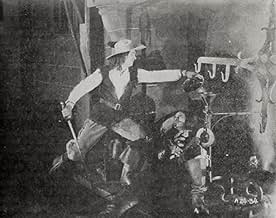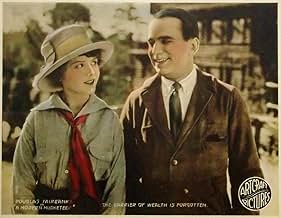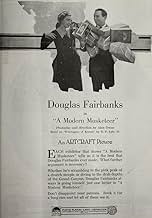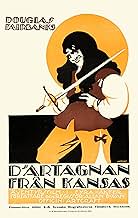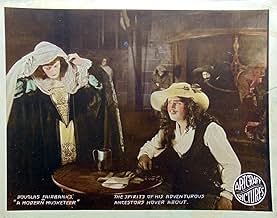Aggiungi una trama nella tua linguaA restless young man travels west, encountering adventure, romance, and danger.A restless young man travels west, encountering adventure, romance, and danger.A restless young man travels west, encountering adventure, romance, and danger.
- Regia
- Sceneggiatura
- Star
Zasu Pitts
- A Kansas Belle
- (non citato nei titoli originali)
Charles Stevens
- Indian
- (non citato nei titoli originali)
Recensioni in evidenza
Turner Classic Movies showed a complete print of "A Modern Musketeer" last night, March 20, 2008. The credit at the end identified the movie as a 2006 Danish Film Archive restoration. TCM added a Monte Alto Orchestra score to the silent. The Danish Archive did a mighty fine job restoring the movie, if the the print had any speckles, fading or snow, I missed seeing them. The miracles of a frame-by-frame computer restoration of a 90+ year old movie.
The movie itself is a showcase for Douglas Fairbanks' acrobatic talents. His playing a role set in the present does not stop him from doing a handstand at the edge of a precipice, getting onto a horse by leaping onto the saddle without using a stirrup (Steve McQueen did that too in his western TV series, but Fairbanks does the leap further from the saddle) and sliding in and out of cut stone windows at every opportunity.
This movie shows that in 1917 Hollywood art directors were on the ball. At the end, the movie's interior action takes place in a set that represents an Anasazi cave dwelling. This cave set sure looks authentic to me. The director Alan Dwan later said that in a Fairbanks movie everything was arranged to make it look as if Fairbanks was not exerting himself as he performed his stunts. So the height of windows in the cave set allow Fairbanks to fly though them. Outside of this set, much of the action seems to take place on the south rim of the Grand Canyon, not far from the El Tovar hotel.
If the El Tovar hotel gave the cast and crew of this movie free or discounted accommodations, I would not be surprised. At every chance, the movie uses vistas of the Grand Canyon as background for the action. The El Tovar hotel must have seen a spike in tourists staying at the hotel after the movie came out, moviegoers who became tourists.
The movie's story is pretty lame. Fairbanks rescues the girl from not one, but two villains. But the story is important only in that it showcases Fairbanks the personality and the stunt man. Thanks to the Danish film archive and TCM, this Fairbanks star vehicle is again available for viewing (when TCM shows it again). ---
Addition (26 July 2009): I finally bought on sale A Modern Musketeer on DVD as part of the Douglas Fairbanks 5 DVD movie box set of the same name. The one thing that stands out for me now is how advanced most of the movie image framing and editing is. For a 1917 movie, you expect and usually get interior scenes that are static with the camera too far from the actors, as if filming a stage play. Even in 1924's The Sea Hawk, the scenes inside the family manor were shot wide a lot, with few medium close-ups. Not in the case in A Modern Musketeer, where director Dwan keeps the camera much closer to the actors, even when the Grand Canyon is the backdrop, varying the shot selection a lot, just like in movies made decades later.
On the commentary track, the film experts mentioned how many scenes in the movie were shot at less than 24 frames per second, adding speed to the action. I did not notice that undercranking when I saw the movie now, but I did notice that Dwan used an awful lot of setups to film the action from different perspectives. One commentator mentioned how good the wide angle chase scene through the wide floor of the canyon (an area now probably flooded by Lake Meade) must have looked when the original, undamaged print was projected on the big screen in the Rivoli Theater in 1917, as first one group of riders, than a second, take off after Fairbanks and company on the run on horseback. Dwan took advantage of the majestic location to make this wide angle shot, which would look at home in a modern Western except for the missing inserts showing close up shots of the riders. But then, Dwan doesn't overdo the editing, no jump cuts for him either.
The commentators mentioned that other filmmakers copied some scenes in the movie, indicating one streetcar scene that Harold Lloyd used and a "cyclone" scene in Kansas with a house falling down that Buster Keaton referred to years later. I think that Dwan's style of editing and framing scenes must have been copied as well. What also stands out for me, though, is how Dwan, with the limited camera technology then available, moved the camera every which way with loads of setups to compensate for the lack of close-up lenses, no use then (as far as I know) of cameras on rails and managing to film those location scenes at the Grand Canyon using orthochromatic film (the last mostly the responsibility of ace cinematographer Hugh McClung).
The movie itself is a showcase for Douglas Fairbanks' acrobatic talents. His playing a role set in the present does not stop him from doing a handstand at the edge of a precipice, getting onto a horse by leaping onto the saddle without using a stirrup (Steve McQueen did that too in his western TV series, but Fairbanks does the leap further from the saddle) and sliding in and out of cut stone windows at every opportunity.
This movie shows that in 1917 Hollywood art directors were on the ball. At the end, the movie's interior action takes place in a set that represents an Anasazi cave dwelling. This cave set sure looks authentic to me. The director Alan Dwan later said that in a Fairbanks movie everything was arranged to make it look as if Fairbanks was not exerting himself as he performed his stunts. So the height of windows in the cave set allow Fairbanks to fly though them. Outside of this set, much of the action seems to take place on the south rim of the Grand Canyon, not far from the El Tovar hotel.
If the El Tovar hotel gave the cast and crew of this movie free or discounted accommodations, I would not be surprised. At every chance, the movie uses vistas of the Grand Canyon as background for the action. The El Tovar hotel must have seen a spike in tourists staying at the hotel after the movie came out, moviegoers who became tourists.
The movie's story is pretty lame. Fairbanks rescues the girl from not one, but two villains. But the story is important only in that it showcases Fairbanks the personality and the stunt man. Thanks to the Danish film archive and TCM, this Fairbanks star vehicle is again available for viewing (when TCM shows it again). ---
Addition (26 July 2009): I finally bought on sale A Modern Musketeer on DVD as part of the Douglas Fairbanks 5 DVD movie box set of the same name. The one thing that stands out for me now is how advanced most of the movie image framing and editing is. For a 1917 movie, you expect and usually get interior scenes that are static with the camera too far from the actors, as if filming a stage play. Even in 1924's The Sea Hawk, the scenes inside the family manor were shot wide a lot, with few medium close-ups. Not in the case in A Modern Musketeer, where director Dwan keeps the camera much closer to the actors, even when the Grand Canyon is the backdrop, varying the shot selection a lot, just like in movies made decades later.
On the commentary track, the film experts mentioned how many scenes in the movie were shot at less than 24 frames per second, adding speed to the action. I did not notice that undercranking when I saw the movie now, but I did notice that Dwan used an awful lot of setups to film the action from different perspectives. One commentator mentioned how good the wide angle chase scene through the wide floor of the canyon (an area now probably flooded by Lake Meade) must have looked when the original, undamaged print was projected on the big screen in the Rivoli Theater in 1917, as first one group of riders, than a second, take off after Fairbanks and company on the run on horseback. Dwan took advantage of the majestic location to make this wide angle shot, which would look at home in a modern Western except for the missing inserts showing close up shots of the riders. But then, Dwan doesn't overdo the editing, no jump cuts for him either.
The commentators mentioned that other filmmakers copied some scenes in the movie, indicating one streetcar scene that Harold Lloyd used and a "cyclone" scene in Kansas with a house falling down that Buster Keaton referred to years later. I think that Dwan's style of editing and framing scenes must have been copied as well. What also stands out for me, though, is how Dwan, with the limited camera technology then available, moved the camera every which way with loads of setups to compensate for the lack of close-up lenses, no use then (as far as I know) of cameras on rails and managing to film those location scenes at the Grand Canyon using orthochromatic film (the last mostly the responsibility of ace cinematographer Hugh McClung).
Douglas Fairbanks' lasting image on the screen is one of a swashbuckling hero whose athletic skills, in which he performed all his stunts, has become unparalleled in cinema. The actor presaged his famous adventurer persona in December 1917's "The Modern Musketeer." This movie marked the first appearance of his sword fighting skills, appearing in a flashback prologue where Fairbanks, to protect the integrity of a woman's handkerchief, takes on all of the tavern's clientele in an action-packed opening scene.
"The Modern Musketeer" also showcases his tremendous physical agility behind a Grand Canyon backdrop. Director Allan Dwan, who wrote the scenario based on "D'Artagnan of Kansas," by E. P. Lyle, Jr., was able to use the canyon grounds just before the area was declared a national park two years later, where the United States Park Service disallowed filming future dramatic movies within its borders. Fairbanks' hand-stand on the edge of a canyon cliff still has modern audiences gasping for breath, as well as an earlier scene where he climbs atop a church steeple.
After a string of highly-praised and enduring comedy Fairbanks films with screenwriter Anita Loos, "The Modern Musketeer" marked the break between the actor and the scriptwriter and her partner's John Emerson's direction. Ms. Loos was offered more money by the Famous Players-Lasky Studio to work for its New York unit rather than Fairbanks' California subsidiary within the same company.
The actor capitalized on his sudden fame by writing a self-help book, "Laugh and Live," in 1917, which emphasizes the power of positive thinking and raising one's confidence through health (food and exercise), business opportunities and social contacts.
"The Modern Musketeer" also showcases his tremendous physical agility behind a Grand Canyon backdrop. Director Allan Dwan, who wrote the scenario based on "D'Artagnan of Kansas," by E. P. Lyle, Jr., was able to use the canyon grounds just before the area was declared a national park two years later, where the United States Park Service disallowed filming future dramatic movies within its borders. Fairbanks' hand-stand on the edge of a canyon cliff still has modern audiences gasping for breath, as well as an earlier scene where he climbs atop a church steeple.
After a string of highly-praised and enduring comedy Fairbanks films with screenwriter Anita Loos, "The Modern Musketeer" marked the break between the actor and the scriptwriter and her partner's John Emerson's direction. Ms. Loos was offered more money by the Famous Players-Lasky Studio to work for its New York unit rather than Fairbanks' California subsidiary within the same company.
The actor capitalized on his sudden fame by writing a self-help book, "Laugh and Live," in 1917, which emphasizes the power of positive thinking and raising one's confidence through health (food and exercise), business opportunities and social contacts.
DOUGLAS FAIRBANKS was quite the swashbuckler of his era in the 1920s, especially during the time of his biggest triumphs in ROBIN HOOD, THE THIEF OF BAGDAD, THE MARK OF ZORRO and THE BLACK PIRATE.
But this is an early relic from his silent screen career as early as 1917, and, of course, has to be judged by today's standards of film-making for any potential viewers outside of curious film buffs who want to see it.
Fairbanks was athletic and agile enough, but always looked middle-aged, even though here he's only 34. Furthermore, he looked husky rather than trim--unlike his son, Douglas Fairbanks, Jr., a much better looking man. But his physical prowess is amazing. He clambers over fences, cars, horses in a mere jump. He climbs up over anything in his way with the ease of a monkey swinging through trees, exuberantly smiling while he struts his way through whatever impediment is in his way.
And the film itself, for a relic that was filmed in 1917, is in amazingly good condition, fully restored and with a jaunty background score that is not jarring and obtrusive the way so many of the silent film scores were.
The story is really two stories that run concurrently: the D'Artagnan legend is illustrated in a few brief scenes of derring-do with Fairbanks rescuing a damsel in distress. The young Kansas man who desperately wants to leave his provincial roots (in a scene deliriously overplayed by Fairbanks) is also anxious to have a life of adventure and romance, like D'Artagnan. His father and mother give him their blessing and send him on his way--and the rest of the plot is predictable but fun to watch as he finds his own damsel in distress to rescue from a villainous man.
Fun, and thin on plot--but it does move as briskly as Fairbanks himself. Amusing to realize that only twenty years later, his son, Douglas Fairbanks, Jr. would be in a little swashbuckler called THE PRISONER OF ZENDA.
But this is an early relic from his silent screen career as early as 1917, and, of course, has to be judged by today's standards of film-making for any potential viewers outside of curious film buffs who want to see it.
Fairbanks was athletic and agile enough, but always looked middle-aged, even though here he's only 34. Furthermore, he looked husky rather than trim--unlike his son, Douglas Fairbanks, Jr., a much better looking man. But his physical prowess is amazing. He clambers over fences, cars, horses in a mere jump. He climbs up over anything in his way with the ease of a monkey swinging through trees, exuberantly smiling while he struts his way through whatever impediment is in his way.
And the film itself, for a relic that was filmed in 1917, is in amazingly good condition, fully restored and with a jaunty background score that is not jarring and obtrusive the way so many of the silent film scores were.
The story is really two stories that run concurrently: the D'Artagnan legend is illustrated in a few brief scenes of derring-do with Fairbanks rescuing a damsel in distress. The young Kansas man who desperately wants to leave his provincial roots (in a scene deliriously overplayed by Fairbanks) is also anxious to have a life of adventure and romance, like D'Artagnan. His father and mother give him their blessing and send him on his way--and the rest of the plot is predictable but fun to watch as he finds his own damsel in distress to rescue from a villainous man.
Fun, and thin on plot--but it does move as briskly as Fairbanks himself. Amusing to realize that only twenty years later, his son, Douglas Fairbanks, Jr. would be in a little swashbuckler called THE PRISONER OF ZENDA.
Although best known for his swashbuckling adventure films of the 1920s like THE MARK OF ZORRO, THE BLACK PIRATE and THE THREE MUSKETEERS, Douglas Fairbanks was already wowing the audiences in earlier years from 1915 onwards, particularly with his amazing physical feats which led to his more famous action hero roles of the 20s. In fact, many of his pre-1920 films have more raw action and amazing feats than the more sophisticated productions of later years, and A MODERN MUSKETEER is a prime example: one astonishing action sequence shows Fairbanks doing some running somersaults, leaping over walls and then a horse in a single bound before virtually running up a perpendicular church wall and its steeple with the speed and ease of a monkey! Anyone who has thrilled to other early Fairbanks films like WILD AND WOOLLY, MANHATTAN MADNESS and HIS MAJESTY, THE American will surely be as amazed and entertained as I was to watch A MODERN MUSKETEER. Although it's incomplete, with only the first 3 reels surviving, it showcases the trademark comedy and action talents of Douglas Fairbanks in his years leading up to his biggest film successes. A few short scenes show Fairbanks as D'Artagnan a foretaste of his later success in THE THREE MUSKETEERS, and then the story revolves around a young man from Kansas who, like D'Artagnan, is always looking to rescue a damsel in distress. It is wildly funny, and despite its missing ending, really worth while viewing.
Modern Musketeer, The (1917)
*** (out of 4)
Fun silent film has Douglas Fairbanks playing a man living in Kansas with his parents who dreams of a more exciting life. Ever since he was a child his mother read to him The Three Musketeers so as an adult he grows tired of his town and heads out west in hopes of romance and adventure. Until recently the second half of this film was lost but it was eventually found and the film recently premiered on Turner Classic Movies. A lot of lost movies that get found are usually big letdowns but this film here actually is pretty good and should keep action fans entertained. The film opens up with a wild, ten minute sequence, which contains just about every type of action you can imagine. We have wild fist fights, broken glasses and various other items. The lively action at the start of the film makes the movie slow down a tad too much in the middle but the movie ends with more great action as Fairbanks must battle Indians. Fairbanks is very energetic in his role and makes a great character here. Another bonus is a terrific wind storm that happens at the start of the film and the special effects here of the city being blown down are very good for their time. Future director Victor Fleming worked as the cinematographer.
*** (out of 4)
Fun silent film has Douglas Fairbanks playing a man living in Kansas with his parents who dreams of a more exciting life. Ever since he was a child his mother read to him The Three Musketeers so as an adult he grows tired of his town and heads out west in hopes of romance and adventure. Until recently the second half of this film was lost but it was eventually found and the film recently premiered on Turner Classic Movies. A lot of lost movies that get found are usually big letdowns but this film here actually is pretty good and should keep action fans entertained. The film opens up with a wild, ten minute sequence, which contains just about every type of action you can imagine. We have wild fist fights, broken glasses and various other items. The lively action at the start of the film makes the movie slow down a tad too much in the middle but the movie ends with more great action as Fairbanks must battle Indians. Fairbanks is very energetic in his role and makes a great character here. Another bonus is a terrific wind storm that happens at the start of the film and the special effects here of the city being blown down are very good for their time. Future director Victor Fleming worked as the cinematographer.
Lo sapevi?
- QuizMarjorie Daw and Kathleen Kirkham, daughter and mother, were seven years apart in age. Daw was only 15(!) when this film was made, which means that she was closer in age to the actress playing her mother than she was to the actor playing her leading man (Douglas Fairbanks was 18 years her senior).
- BlooperWhen Chin-de-dah leads Vandeteer and Elsie through the Canyon, the shadows of the cameraman and another crew member are visible on the ground.
- Curiosità sui creditiExcept for Douglas Fairbanks, whose name appears above the title, there is no cast list. Actors are introduced by intertitle cards just before they appear on the screen. The IMDb cast list therefore uses this "order of appearance" sequence.
- Versioni alternativeIn 2006, the Danish Film Institute copyrighted a 68-minute version of this film, with a musical score played by the Mont Alto Orchestra. Additional restoration and music credits stretch the time to 69 minutes.
- ConnessioniReferenced in Charlot - Chaplin (1992)
I più visti
Accedi per valutare e creare un elenco di titoli salvati per ottenere consigli personalizzati
Dettagli
- Tempo di esecuzione1 ora 8 minuti
- Mix di suoni
- Proporzioni
- 1.33 : 1
Contribuisci a questa pagina
Suggerisci una modifica o aggiungi i contenuti mancanti

Divario superiore
By what name was A Modern Musketeer (1917) officially released in Canada in English?
Rispondi
